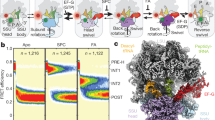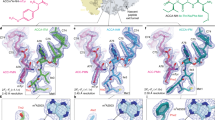Abstract
Aminoglycoside-class antibiotics bind directly to ribosomal RNA, imparting pleiotropic effects on ribosome function. Despite in-depth structural investigations of aminoglycoside–RNA oligonucleotide and aminoglycoside-ribosome interactions, mechanisms explaining the unique ribosome inhibition profiles of chemically similar aminoglycosides remain elusive. Here, using single-molecule fluorescence resonance energy transfer (smFRET) methods, we show that high-affinity aminoglycoside binding to the conserved decoding site region of the functional pre-translocation ribosome complex specifically remodels the nature of intrinsic dynamic processes within the particle. The extents of these effects, which are distinct for each member of the aminoglycoside class, strongly correlate with their inhibition of EF-G–catalyzed translocation. Neomycin, a 4,5-linked aminoglycoside, binds with lower affinity to one or more secondary binding sites, mediating distinct structural and dynamic perturbations that further enhance translocation inhibition. These new insights help explain why closely related aminoglycosides elicit pleiotropic translation activities and demonstrate the potential utility of smFRET as a tool for dissecting the mechanisms of antibiotic action.
This is a preview of subscription content, access via your institution
Access options
Subscribe to this journal
Receive 12 print issues and online access
$259.00 per year
only $21.58 per issue
Buy this article
- Purchase on Springer Link
- Instant access to full article PDF
Prices may be subject to local taxes which are calculated during checkout







Similar content being viewed by others
Change history
12 February 2010
In the version of this article initially published, in the key for Figure 6a, the units for two of the inhibitor concentrations were incorrectly labeled as “M”, where they should have read “µM”. The error has been corrected in the HTML and PDF versions of the article.
References
Rodnina, M.V., Gromadski, K.B., Kothe, U. & Wieden, H.J. Recognition and selection of tRNA in translation. FEBS Lett. 579, 938–942 (2005).
Shoji, S., Walker, S.E. & Fredrick, K. Ribosomal translocation: one step closer to the molecular mechanism. ACS Chem. Biol. 4, 93–107 (2009).
Korostelev, A., Trakhanov, S., Laurberg, M. & Noller, H.F. Crystal structure of a 70S ribosome-tRNA complex reveals functional interactions and rearrangements. Cell 126, 1065–1077 (2006).
Selmer, M. et al. Structure of the 70S ribosome complexed with mRNA and tRNA. Science 313, 1935–1942 (2006).
Yusupov, M.M. et al. Crystal structure of the ribosome at 5.5 angstrom resolution. Science 292, 883–896 (2001).
Munro, J.B., Sanbonmatsu, K.Y., Spahn, C.M. & Blanchard, S. Navigating the ribosome's metastable energy landscape. Trends Biochem. Sci. 34, 390–400 (2009).
Semenkov, Y.P., Rodnina, M.V. & Wintermeyer, W. Energetic contribution of tRNA hybrid state formation to translocation catalysis on the ribosome. Nat. Struct. Biol. 7, 1027–1031 (2000).
Sharma, D., Southworth, D.R. & Green, R. EF-G-independent reactivity of a pre-translocation-state ribosome complex with the aminoacyl tRNA substrate puromycin supports an intermediate (hybrid) state of tRNA binding. RNA 10, 102–113 (2004).
Dorner, S., Brunelle, J.L., Sharma, D. & Green, R. The hybrid state of tRNA binding is an authentic translation elongation intermediate. Nat. Struct. Mol. Biol. 13, 234–241 (2006).
Frank, J., Gao, H., Sengupta, J., Gao, N. & Taylor, D.J. The process of mRNA-tRNA translocation. Proc. Natl. Acad. Sci. USA 104, 19671–19678 (2007).
Marshall, R.A., Aitken, C.E., Dorywalska, M. & Puglisi, J.D. Translation at the single-molecule level. Annu. Rev. Biochem. 77, 177–203 (2008).
Munro, J.B., Altman, R.B., O'Connor, N. & Blanchard, S.C. Identification of two distinct hybrid state intermediates on the ribosome. Mol. Cell 25, 505–517 (2007).
Green, R. & Noller, H.F. Ribosomes and translation. Annu. Rev. Biochem. 66, 679–716 (1997).
Munro, J.B., Vaiana, A., Sanbonmatsu, K.Y. & Blanchard, S.C. A new view of protein synthesis: mapping the free energy landscape of the ribosome using single-molecule FRET. Biopolymers 89, 565–577 (2008).
Davies, J. & Davis, B.D. Misreading of ribonucleic acid code words induced by aminoglycoside antibiotics: the effect of drug concentration. J. Biol. Chem. 243, 3312–3316 (1968).
Cabanas, M.J., Vazquez, D. & Modolell, J. Inhibition of ribosomal translocation by aminoglycoside antibiotics. Biochem. Biophys. Res. Commun. 83, 991–997 (1978).
Misumi, M., Nishimura, T., Komai, T. & Tanaka, N. Interaction of kanamycin and related antibiotics with the large subunit of ribosomes and the inhibition of translocation. Biochem. Biophys. Res. Commun. 84, 358–365 (1978).
Fredrick, K. & Noller, H. Catalysis of ribosomal translocation by sparsomycin. Science 300, 1159–1162 (2003).
Studer, S.M., Feinberg, J.S. & Joseph, S. Rapid kinetic analysis of EF-G-dependent mRNA translocation in the ribosome. J. Mol. Biol. 327, 369–381 (2003).
Peske, F., Savelsbergh, A., Katunin, V.I., Rodnina, M.V. & Wintermeyer, W. Conformational changes of the small ribosomal subunit during elongation factor G-dependent tRNA-mRNA translocation. J. Mol. Biol. 343, 1183–1194 (2004).
Hirokawa, G. et al. Post-termination complex disassembly by ribosome recycling factor, a functional tRNA mimic. EMBO J. 21, 2272–2281 (2002).
Puglisi, J.D. et al. Aminoglycoside antibiotics and decoding. in The Ribosome: Structure, Function, Antibiotics, and Cellular Interactions (eds. Garrett, R.A. et al.) 419–429 (American Society for Microbiology Press, Washington, DC, 2000).
Ogle, J.M., Carter, A.P. & Ramakrishnan, V. Insights into the decoding mechanism from recent ribosome structures. Trends Biochem. Sci. 28, 259–266 (2003).
Jerinic, O. & Joseph, S. Conformational changes in the ribosome induced by translational miscoding agents. J. Mol. Biol. 304, 707–713 (2000).
Fast, R., Eberhard, T.H., Ruusala, T. & Kurland, C.G. Does streptomycin cause an error catastrophe? Biochimie 69, 131–136 (1987).
Kurland, C.G. Translational accuracy and the fitness of bacteria. Annu. Rev. Genet. 26, 29–50 (1992).
Sander, P., Prammananan, T. & Böttger, E.C. Introducing mutations into a chromosomal rRNA gene using a genetically modified eubacterial host with a single rRNA operon. Mol. Microbiol. 22, 841–848 (1996).
Prammananan, T. et al. A single 16S ribosomal RNA substitution is responsible for resistance to amikacin and other 2-deoxystreptamine aminoglycosides in Mycobacterium abscessus and Mycobacterium chelonae. J. Infect. Dis. 177, 1573–1581 (1998).
Recht, M.I., Douthwaite, S. & Puglisi, J.D. Basis for prokaryotic specificity of action of aminoglycoside antibiotics. EMBO J. 18, 3133–3138 (1999).
Böttger, E.C., Springer, B., Prammananan, T., Kidan, Y. & Sander, P. Structural basis for selectivity and toxicity of ribosomal antibiotics. EMBO Rep. 2, 318–323 (2001).
Blanchard, S.C., Kim, H.D., Gonzalez, R.L., Jr., Puglisi, J.D. & Chu, S. tRNA dynamics on the ribosome during translation. Proc. Natl. Acad. Sci. USA 101, 12893–12898 (2004).
Ryu, D.H., Litovchick, A. & Rando, R.R. Stereospecificity of aminoglycoside-ribosomal interactions. Biochemistry 41, 10499–10509 (2002).
Sucheck, S.J. et al. Design of bifunctional antibiotics that target bacterial rRNA and inhibit resistance-causing enzymes. J. Am. Chem. Soc. 122, 5230–5231 (2000).
Ermolenko, D.N. et al. The antibiotic viomycin traps the ribosome in an intermediate state of translocation. Nat. Struct. Mol. Biol. 14, 493–497 (2007).
Borovinskaya, M.A. et al. Structural basis for aminoglycoside inhibition of bacterial ribosome recycling. Nat. Struct. Mol. Biol. 14, 727–732 (2007).
Semenkov, Y., Shapkina, T., Makhno, V. & Kirillov, S. Puromycin reaction for the A site-bound peptidyl-tRNA. FEBS Lett. 296, 207–210 (1992).
Johansen, S.K., Maus, C.E., Plikaytis, B.B. & Douthwaite, S. Capreomycin binds across the ribosomal subunit interface using tlyA-encoded 2′-O-methylations in 16S and 23S rRNAs. Mol. Cell 23, 173–182 (2006).
Cornish, P.V., Ermolenko, D.N., Noller, H.F. & Ha, T. Spontaneous intersubunit rotation in single ribosomes. Mol. Cell 30, 578–588 (2008).
Pan, D., Kirillov, S. & Cooperman, B.S. Kinetically competent intermediates in the translocation step of protein synthesis. Mol. Cell 25, 519–529 (2007).
Kim, H.D., Puglisi, J.D. & Chu, S. Fluctuations of transfer RNAs between classical and hybrid states. Biophys. J. 93, 3575–3582 (2007).
Yamada, T., Teshima, T., Shiba, T. & Nierhaus, K.H. The translocation inhibitor tuberactinomycin binds to nucleic acids and blocks the in vitro assembly of 50S subunits. Nucleic Acids Res. 8, 5767–5777 (1980).
Buchan, J.R. & Stansfield, I. Halting a cellular production line: responses to ribosomal pausing during translation. Biol. Cell 99, 475–487 (2007).
Kaul, M. & Pilch, D.S. Thermodynamics of aminoglycoside-rRNA recognition: the binding of neomycin-class aminoglycosides of the A site of 16S rRNA. Biochemistry 41, 7695–7706 (2002).
Vaiana, A.C. & Sanbonmatsu, K.Y. Stochastic gating and drug-ribosome interactions. J. Mol. Biol. 386, 648–661 (2008).
Karimi, R. & Ehrenberg, M. Dissociation rates of peptidyl-tRNA from the P-site of E. coli ribosomes. EMBO J. 15, 1149–1154 (1996).
Nierhaus, K.H. The allosteric three-site model for the ribosomal elongation cycle: features and future. Biochemistry 29, 4997–5008 (1990).
Zaher, H.S. & Green, R. Quality control by the ribosome following peptide bond formation. Nature 457, 161–166 (2009).
Campuzano, S., Vazquez, D. & Modolell, J. Dissociation of guanosine nucleotide-elongation factor G-ribosome complexes. Biochemistry 18, 1570–1574 (1979).
Valle, M. et al. Locking and unlocking of ribosomal motions. Cell 114, 123–134 (2003).
Zavialov, A.V. & Ehrenberg, M. Peptidyl-tRNA regulates the GTPase activity of translation factors. Cell 114, 113–122 (2003).
Youngman, E.M. & Green, R. Affinity purification of in vivo-assembled ribosomes for in vitro biochemical analysis. Methods 36, 305–312 (2005).
Qin, F. Principles of single-channel kinetic analysis. Methods Mol. Biol. 403, 253–286 (2007).
Acknowledgements
The authors thank J. Munro for comments and suggestions during the preparation of this manuscript and for the generation of ribosome structural diagrams. We thank all members of the laboratory for their constructive comments during preparation of this manuscript, as well as R. Green (Johns Hopkins School of Medicine, Howard Hughes Medical Institute) for providing MS2-tagged rRNA constructs. This work was supported by the US National Institute of General Medical Sciences (5R01GM079238-03), New York State Foundation for Science, Technology and Innovation, and a US National Science Foundation CAREER award. M.B.F. is a trainee in the Weill Cornell/Rockefeller University/Sloan-Kettering Tri-Institutional MD-PhD Program supported by US National Institutes of Health Medical Scientist Training Program grant GM07739. D.S.T. is supported by the Tri-Institutional Training Program in Computational Biology and Medicine.
Author information
Authors and Affiliations
Contributions
M.B.F. and S.C.B. designed the research. M.B.F. performed the smFRET experiments. D.S.T. implemented the automated analysis software, and D.S.T. and M.B.F. performed the data analysis. R.B.A. prepared the dye-labeled tRNA and ribosome complexes and reagents for the smFRET experiments. M.B.F., D.S.T. and S.C.B. prepared the manuscript.
Corresponding author
Supplementary information
Supplementary Text and Figures
Supplementary Figures 1–11, Supplementary Tables 1–3 and Supplementary Methods (PDF 5388 kb)
Rights and permissions
About this article
Cite this article
Feldman, M., Terry, D., Altman, R. et al. Aminoglycoside activity observed on single pre-translocation ribosome complexes. Nat Chem Biol 6, 54–62 (2010). https://doi.org/10.1038/nchembio.274
Received:
Accepted:
Published:
Issue Date:
DOI: https://doi.org/10.1038/nchembio.274
This article is cited by
-
Molecular basis of the pleiotropic effects by the antibiotic amikacin on the ribosome
Nature Communications (2023)
-
Potential for the Development of a New Generation of Aminoglycoside Antibiotics
Pharmaceutical Chemistry Journal (2021)
-
Destination of aminoglycoside antibiotics in the ‘post-antibiotic era’
The Journal of Antibiotics (2018)
-
Multiperspective smFRET reveals rate-determining late intermediates of ribosomal translocation
Nature Structural & Molecular Biology (2016)
-
Fluctuations between multiple EF-G-induced chimeric tRNA states during translocation on the ribosome
Nature Communications (2015)



